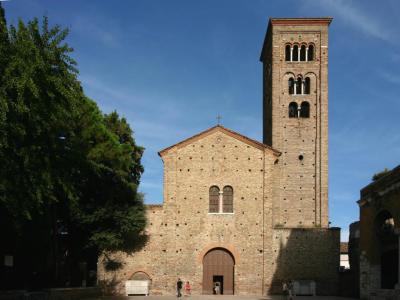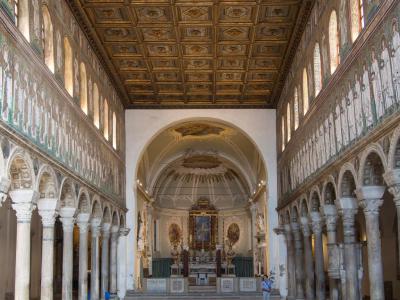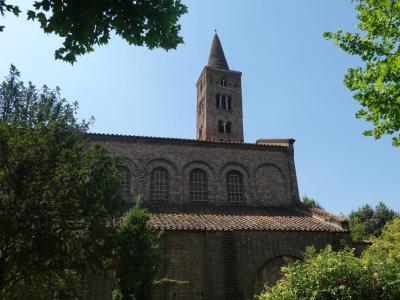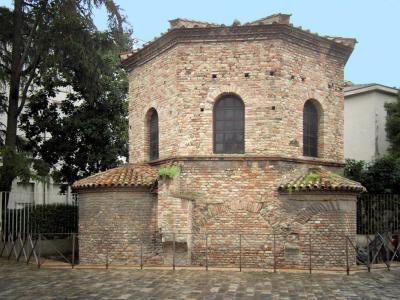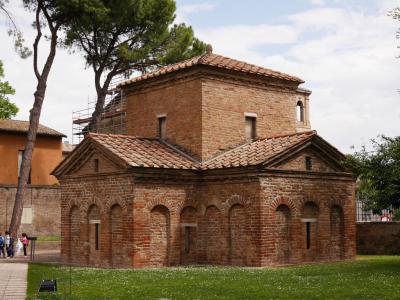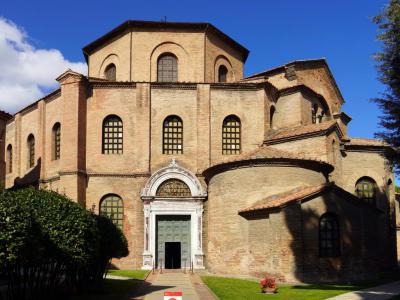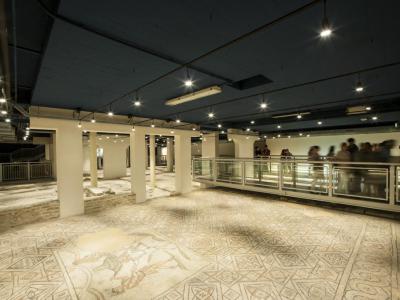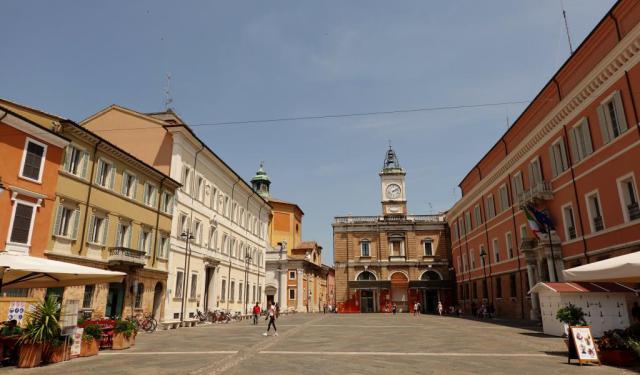Byzantine Mosaics Walking Tour (Self Guided), Ravenna
What are precious jewels, you may ask. Well, let me tell you – Ravenna’s Byzantine mosaics are surely among the most sparkling, spectacular, and valuable. So much so that they were recognized as World Heritage by UNESCO in 1996.
Indeed, Ravenna is like no other place in Italy, and the magnificence of its mosaics can leave you with a stiff neck. The intricate mosaic work achieved some of its greatest heights here.
The Basilica of San Francesco features mosaic decorations from the 5th and 6th centuries, showcasing biblical scenes and the life of Christ. The Basilica of Saint Apollinaris the New boasts a remarkable mosaic cycle depicting saints, martyrs, and biblical stories, offering a vivid narrative of the Christian faith.
Meanwhile, the San Giovanni Evangelista Church features mosaics that blend classical and Christian motifs, illustrating the evolving artistic influences of the time.
The Arian Baptistery (Battistero degli Ariani) displays mosaics that reflect the theological differences of the Arian Christian sect. These mosaics are a unique window into the religious diversity of the era.
The Mausoleum of Galla Placidia showcases a stunning blue mosaic sky adorned with golden stars and is considered one of the most impressive examples of early Christian art.
The Basilica of San Vitale boasts breathtaking mosaic images of Emperor Justinian and Empress Theodora, along with scenes from the Old and New Testaments. These mosaics reflect the intertwining of religion and politics during this time.
Lastly, the Domus of the Stone Carpets offers a glimpse into the daily life of Ravenna's Byzantine inhabitants through its intricate floor mosaics.
To fully appreciate the remarkable mosaic artworks in Ravenna, we encourage you to visit these historic sites. But note: the greatest danger associated with it is becoming overwhelmed by the sheer magnitude of the mosaics, so by the time you reach the last attractions, you simply cannot absorb any more. For this reason, it's a good idea to plan your visit and summon your strength in advance.
Indeed, Ravenna is like no other place in Italy, and the magnificence of its mosaics can leave you with a stiff neck. The intricate mosaic work achieved some of its greatest heights here.
The Basilica of San Francesco features mosaic decorations from the 5th and 6th centuries, showcasing biblical scenes and the life of Christ. The Basilica of Saint Apollinaris the New boasts a remarkable mosaic cycle depicting saints, martyrs, and biblical stories, offering a vivid narrative of the Christian faith.
Meanwhile, the San Giovanni Evangelista Church features mosaics that blend classical and Christian motifs, illustrating the evolving artistic influences of the time.
The Arian Baptistery (Battistero degli Ariani) displays mosaics that reflect the theological differences of the Arian Christian sect. These mosaics are a unique window into the religious diversity of the era.
The Mausoleum of Galla Placidia showcases a stunning blue mosaic sky adorned with golden stars and is considered one of the most impressive examples of early Christian art.
The Basilica of San Vitale boasts breathtaking mosaic images of Emperor Justinian and Empress Theodora, along with scenes from the Old and New Testaments. These mosaics reflect the intertwining of religion and politics during this time.
Lastly, the Domus of the Stone Carpets offers a glimpse into the daily life of Ravenna's Byzantine inhabitants through its intricate floor mosaics.
To fully appreciate the remarkable mosaic artworks in Ravenna, we encourage you to visit these historic sites. But note: the greatest danger associated with it is becoming overwhelmed by the sheer magnitude of the mosaics, so by the time you reach the last attractions, you simply cannot absorb any more. For this reason, it's a good idea to plan your visit and summon your strength in advance.
How it works: Download the app "GPSmyCity: Walks in 1K+ Cities" from Apple App Store or Google Play Store to your mobile phone or tablet. The app turns your mobile device into a personal tour guide and its built-in GPS navigation functions guide you from one tour stop to next. The app works offline, so no data plan is needed when traveling abroad.
Byzantine Mosaics Walking Tour Map
Guide Name: Byzantine Mosaics Walking Tour
Guide Location: Italy » Ravenna (See other walking tours in Ravenna)
Guide Type: Self-guided Walking Tour (Sightseeing)
# of Attractions: 7
Tour Duration: 1 Hour(s)
Travel Distance: 2.0 Km or 1.2 Miles
Author: DanaOffice
Sight(s) Featured in This Guide:
Guide Location: Italy » Ravenna (See other walking tours in Ravenna)
Guide Type: Self-guided Walking Tour (Sightseeing)
# of Attractions: 7
Tour Duration: 1 Hour(s)
Travel Distance: 2.0 Km or 1.2 Miles
Author: DanaOffice
Sight(s) Featured in This Guide:
- Basilica of San Francesco
- Basilica of Sant'Apollinare Nuovo (Basilica of Saint Apollinaris the New)
- San Giovanni Evangelista Church
- Battistero degli Ariani (Arian Baptistery)
- Mausoleum of Galla Placidia
- Basilica of San Vitale
- Domus of the Stone Carpets
1) Basilica of San Francesco
The Basilica of San Francesco dates back to the year 450 when it was originally constructed by Neo, the Bishop of Ravenna. The church was dedicated to Saints Peter and Paul and was also known as the Church of the Apostles. During the latter part of the 9th century and throughout the 10th century, the original church was demolished to make way for a larger church and a tall bell tower, both of which still stand. The newly constructed church was dedicated to Saint Peter and was named San Pietro Maggiore.
In 1261, the church was handed over to the Franciscan order and rededicated to Saint Francis of Assisi. The church played a significant role in history as it hosted Dante Alighieri's funeral in 1321, and his remains still rest in the Tomb of Dante located next to the church.
Throughout the 16th to 18th centuries, the church underwent several restoration efforts and saw the addition of Baroque altars and decorations. In preparation for the 600th anniversary of Dante's death between 1918 and 1921, the church underwent a radical restoration that removed the Baroque additions and returned it to its original style. During this time, a competition was held for a new interior design scheme based on Dante's most famous work, the Divine Comedy. Adolfo De Carolis won the competition but was unable to see his scheme realized due to his untimely death.
The Crypt of the Basilica of San Francesco, located beneath the presbytery of the basilica is accessible through a double flight of stairs.
Beneath the altar, a small arched window with a protective balustrade offers a breathtaking view of the mosaic floor submerged in groundwater. The water's level in the crypt varies depending on rainfall and sea level. It's important to note that the water here is not from the sea but rather filtered fresh water, as evidenced by the presence of dozens of goldfish swimming gracefully among the colorful mosaic patterns.
The mosaics that adorn the crypt's floor are of great historical significance, dating back to the late ancient period, specifically the 5th century AD. These mosaics underwent restoration in 1877 to preserve their beauty and historical value. Among these mosaics, one can find two inscriptions, one in Greek and one in Latin, adding to the historical richness of this unique underground space.
In 1261, the church was handed over to the Franciscan order and rededicated to Saint Francis of Assisi. The church played a significant role in history as it hosted Dante Alighieri's funeral in 1321, and his remains still rest in the Tomb of Dante located next to the church.
Throughout the 16th to 18th centuries, the church underwent several restoration efforts and saw the addition of Baroque altars and decorations. In preparation for the 600th anniversary of Dante's death between 1918 and 1921, the church underwent a radical restoration that removed the Baroque additions and returned it to its original style. During this time, a competition was held for a new interior design scheme based on Dante's most famous work, the Divine Comedy. Adolfo De Carolis won the competition but was unable to see his scheme realized due to his untimely death.
The Crypt of the Basilica of San Francesco, located beneath the presbytery of the basilica is accessible through a double flight of stairs.
Beneath the altar, a small arched window with a protective balustrade offers a breathtaking view of the mosaic floor submerged in groundwater. The water's level in the crypt varies depending on rainfall and sea level. It's important to note that the water here is not from the sea but rather filtered fresh water, as evidenced by the presence of dozens of goldfish swimming gracefully among the colorful mosaic patterns.
The mosaics that adorn the crypt's floor are of great historical significance, dating back to the late ancient period, specifically the 5th century AD. These mosaics underwent restoration in 1877 to preserve their beauty and historical value. Among these mosaics, one can find two inscriptions, one in Greek and one in Latin, adding to the historical richness of this unique underground space.
2) Basilica of Sant'Apollinare Nuovo (Basilica of Saint Apollinaris the New) (must see)
The Basilica of Saint Apollinaris the New in Ravenna, Italy, holds a rich history. Initially constructed as a palace chapel by the Ostrogothic king Theodoric the Great in the early 6th century, it was dedicated to "Christ the Redeemer" in 504 AD.
In 561 AD, under Byzantine Emperor Justinian I, the church was rededicated as "Sanctus Martinus in Coelo Aureo" ("Saint Martin in Golden Heaven") after suppressing Arianism. It was named in honor of Saint Martin of Tours, a staunch opponent of Arianism.
Legend has it that Pope Gregory the Great ordered the blackening of the church's mosaics because their golden splendor distracted worshippers from their prayers.
The basilica received its present name in 856 AD when relics of Saint Apollinaris were transferred from the Basilica of Sant'Apollinare in Classe due to frequent pirate raids from the Adriatic Sea.
A 16th-century marble portico stands at the church's entrance, and a round bell tower from the 9th or 10th century is located on the right side of the portico.
Over the centuries, the apse and atrium underwent renovations, with some original mosaics being destroyed. Nevertheless, mosaics on the lateral walls, twenty-four columns with simplified Corinthian capitals, and an Ambo have been preserved.
The mosaics were modified in the mid-19th century by Felice Kibel, and the apse was reconstructed after sustaining damage during World War I.
The church's walls feature mosaics depicting Jesus' miracles, parables, saints, prophets, and evangelists. The figures in these mosaics are noted for their individual expressions, following a Hellenistic-Roman tradition.
Some art historians suggest that one of the mosaics contains the first depiction of Satan in Western art. In this mosaic, a blue angel appears on Jesus' left, behind three goats, as mentioned in Saint Matthew's account of Judgement Day.
In 561 AD, under Byzantine Emperor Justinian I, the church was rededicated as "Sanctus Martinus in Coelo Aureo" ("Saint Martin in Golden Heaven") after suppressing Arianism. It was named in honor of Saint Martin of Tours, a staunch opponent of Arianism.
Legend has it that Pope Gregory the Great ordered the blackening of the church's mosaics because their golden splendor distracted worshippers from their prayers.
The basilica received its present name in 856 AD when relics of Saint Apollinaris were transferred from the Basilica of Sant'Apollinare in Classe due to frequent pirate raids from the Adriatic Sea.
A 16th-century marble portico stands at the church's entrance, and a round bell tower from the 9th or 10th century is located on the right side of the portico.
Over the centuries, the apse and atrium underwent renovations, with some original mosaics being destroyed. Nevertheless, mosaics on the lateral walls, twenty-four columns with simplified Corinthian capitals, and an Ambo have been preserved.
The mosaics were modified in the mid-19th century by Felice Kibel, and the apse was reconstructed after sustaining damage during World War I.
The church's walls feature mosaics depicting Jesus' miracles, parables, saints, prophets, and evangelists. The figures in these mosaics are noted for their individual expressions, following a Hellenistic-Roman tradition.
Some art historians suggest that one of the mosaics contains the first depiction of Satan in Western art. In this mosaic, a blue angel appears on Jesus' left, behind three goats, as mentioned in Saint Matthew's account of Judgement Day.
3) San Giovanni Evangelista Church
San Giovanni Evangelista Church is a remarkable place of worship with a history dating back to the fifth century AD. This ancient church was originally constructed under the patronage of the Roman imperial princess Galla Placidia, adding to its historical and architectural significance.
In the Middle Ages, the church was affiliated with an important Benedictine monastery, enhancing its religious and cultural importance. During this period, two of the four bells that still chime from the church's bell tower were cast in the year 1208.
Significant renovations occurred in the 14th century, transforming the church and monastery with the prevailing Gothic architectural style of the time. The legacy of this renovation is still visible today through the church's portal, which showcases Gothic design elements.
Despite its long history, the church went through a period of unfortunate loss in 1747 when many of its mosaics were removed. However, two mosaic fragments from the original 5th-century floor were spared, and these remnants bear witness to the early Christian use of hooked crosses, a notable historical detail.
The church has weathered various challenges, including significant damage during World War II, when it was heavily bombed. Nevertheless, the building was later restored, ensuring its continued existence as a place of both historical and spiritual significance.
Amid these trials, some mosaic fragments from the 13th-century floor survived the devastation caused by World War II. These fragments depict scenes related to the Fourth Crusade, providing an important glimpse into the historical context of the time.
In the Middle Ages, the church was affiliated with an important Benedictine monastery, enhancing its religious and cultural importance. During this period, two of the four bells that still chime from the church's bell tower were cast in the year 1208.
Significant renovations occurred in the 14th century, transforming the church and monastery with the prevailing Gothic architectural style of the time. The legacy of this renovation is still visible today through the church's portal, which showcases Gothic design elements.
Despite its long history, the church went through a period of unfortunate loss in 1747 when many of its mosaics were removed. However, two mosaic fragments from the original 5th-century floor were spared, and these remnants bear witness to the early Christian use of hooked crosses, a notable historical detail.
The church has weathered various challenges, including significant damage during World War II, when it was heavily bombed. Nevertheless, the building was later restored, ensuring its continued existence as a place of both historical and spiritual significance.
Amid these trials, some mosaic fragments from the 13th-century floor survived the devastation caused by World War II. These fragments depict scenes related to the Fourth Crusade, providing an important glimpse into the historical context of the time.
4) Battistero degli Ariani (Arian Baptistery)
The Arian Baptistery is an ancient religious structure. It was constructed during the reign of the Ostrogothic king Theodoric, with construction starting in the late 5th century and being completed in the early 6th century. This baptistery served the Arian Christian community and was originally part of the Arian cathedral, which is now known as the Church of the Holy Spirit.
Designated as a UNESCO World Heritage Site since 1996, the Arian Baptistery is part of the "Early Christian Monuments of Ravenna" serial site. Since December 2014, it has been under the management of the Ministry for Cultural Heritage and Activities, administered by the Emilia-Romagna Museum Centre, which later became the Regional Museums Directorate in December 2019.
The exterior of the baptistery reveals a subsidence of 2.25 meters. It is characterized by its octagonal shape and constructed with bricks. The lower register features apses, while the upper register boasts arched windows. The interior of the baptistery is sparsely adorned, with exposed brickwork and no remaining furnishings. The only remnant of the baptismal font is a circular marble slab located at the center of the building.
The highlight of the Arian Baptistery is its beautifully decorated dome, which is adorned with mosaics. While the mosaic surface is smaller compared to the Neonian Baptistery, the decorative scheme is simpler. The central mosaic features the baptism of Christ by John the Baptist, depicting John, the Jordan River, and the Holy Spirit as a dove. The outermost mosaic register showcases the empty throne of the Ethymasia, symbolizing the second coming of Christ. It includes a jeweled cross resting on a purple cushion and a representation of the twelve holy martyrs, often identified with the twelve apostles.
Designated as a UNESCO World Heritage Site since 1996, the Arian Baptistery is part of the "Early Christian Monuments of Ravenna" serial site. Since December 2014, it has been under the management of the Ministry for Cultural Heritage and Activities, administered by the Emilia-Romagna Museum Centre, which later became the Regional Museums Directorate in December 2019.
The exterior of the baptistery reveals a subsidence of 2.25 meters. It is characterized by its octagonal shape and constructed with bricks. The lower register features apses, while the upper register boasts arched windows. The interior of the baptistery is sparsely adorned, with exposed brickwork and no remaining furnishings. The only remnant of the baptismal font is a circular marble slab located at the center of the building.
The highlight of the Arian Baptistery is its beautifully decorated dome, which is adorned with mosaics. While the mosaic surface is smaller compared to the Neonian Baptistery, the decorative scheme is simpler. The central mosaic features the baptism of Christ by John the Baptist, depicting John, the Jordan River, and the Holy Spirit as a dove. The outermost mosaic register showcases the empty throne of the Ethymasia, symbolizing the second coming of Christ. It includes a jeweled cross resting on a purple cushion and a representation of the twelve holy martyrs, often identified with the twelve apostles.
5) Mausoleum of Galla Placidia (must see)
The Mausoleum of Galla Placidia is a Late Antique Roman structure constructed between 425 and 450 AD. This site was added to the UNESCO World Heritage List in 1996, along with seven other landmarks in Ravenna.
Despite its name, the mausoleum is not the final resting place of Empress Galla Placidia. The misconception that she was buried here dates back to the thirteenth century. In reality, Galla Placidia passed away in Rome and was interred there, likely beside Emperor Honorius in the Mausoleum of Honorius at Old Saint Peter's Basilica.
The "mausoleum" was originally an adjunct to the Church of the Holy Cross (Santa Croce) in Ravenna, constructed in 417 as the church for the imperial palace and probably dedicated to Saint Lawrence. It has a cruciform layout with a central dome supported by pendentives and barrel vaults over its four transepts. A square tower encases the exterior of the dome, rising above the lateral wings with decorative blind arcades. The brick surface is set with narrow mortar joints, and alabaster window panels allow light to enter.
The interior of the mausoleum is adorned with exquisite mosaics. Two notable mosaic lunettes are located inside, and the remainder of the interior is filled with mosaics featuring Christian and Apocalyptic symbols. The mosaics, crafted from glass tesserae, embellish the vaulted ceilings, lunettes, and cupola, showcasing high-quality work. Above the entrance portal, there is a mosaic portraying Christ as the Good Shepherd among his flock.
Despite its name, the mausoleum is not the final resting place of Empress Galla Placidia. The misconception that she was buried here dates back to the thirteenth century. In reality, Galla Placidia passed away in Rome and was interred there, likely beside Emperor Honorius in the Mausoleum of Honorius at Old Saint Peter's Basilica.
The "mausoleum" was originally an adjunct to the Church of the Holy Cross (Santa Croce) in Ravenna, constructed in 417 as the church for the imperial palace and probably dedicated to Saint Lawrence. It has a cruciform layout with a central dome supported by pendentives and barrel vaults over its four transepts. A square tower encases the exterior of the dome, rising above the lateral wings with decorative blind arcades. The brick surface is set with narrow mortar joints, and alabaster window panels allow light to enter.
The interior of the mausoleum is adorned with exquisite mosaics. Two notable mosaic lunettes are located inside, and the remainder of the interior is filled with mosaics featuring Christian and Apocalyptic symbols. The mosaics, crafted from glass tesserae, embellish the vaulted ceilings, lunettes, and cupola, showcasing high-quality work. Above the entrance portal, there is a mosaic portraying Christ as the Good Shepherd among his flock.
6) Basilica of San Vitale (must see)
The Basilica of San Vitale is a significant late antique church with a unique architectural design. Built in the 6th century under the orders of Bishop Ecclesius of Ravenna, it showcases a blend of Roman and Byzantine elements.
The central vault of the church was constructed using a novel technique involving hollow tubes inserted into each other, a pioneering use of terra-cotta forms that later influenced modern structural clay tile construction. The church's octagonal layout combines Roman features such as the dome and doorways with Byzantine elements like the polygonal apse, capitals, narrow bricks, and early examples of flying buttresses.
The Basilica of San Vitale is renowned for its exceptional Byzantine mosaics, which are among the most studied works in Byzantine art. These mosaics are considered the best-preserved outside of Istanbul. The church holds the honorific title of basilica in the Roman Catholic Church due to its historical and ecclesial significance.
Legend has it that the church was built on the site where Saint Vitalis was martyred. The Baroque frescoes on the dome, created in the late 18th century, add to the artistic heritage of this remarkable structure. The bell tower, with four bells, includes a tenor bell dating back to the 16th century. The Basilica of San Vitale is one of the eight structures in Ravenna inscribed on the UNESCO World Heritage List.
The central vault of the church was constructed using a novel technique involving hollow tubes inserted into each other, a pioneering use of terra-cotta forms that later influenced modern structural clay tile construction. The church's octagonal layout combines Roman features such as the dome and doorways with Byzantine elements like the polygonal apse, capitals, narrow bricks, and early examples of flying buttresses.
The Basilica of San Vitale is renowned for its exceptional Byzantine mosaics, which are among the most studied works in Byzantine art. These mosaics are considered the best-preserved outside of Istanbul. The church holds the honorific title of basilica in the Roman Catholic Church due to its historical and ecclesial significance.
Legend has it that the church was built on the site where Saint Vitalis was martyred. The Baroque frescoes on the dome, created in the late 18th century, add to the artistic heritage of this remarkable structure. The bell tower, with four bells, includes a tenor bell dating back to the 16th century. The Basilica of San Vitale is one of the eight structures in Ravenna inscribed on the UNESCO World Heritage List.
7) Domus of the Stone Carpets
The Domus of the Stone Carpets is an intriguing archaeological site. Situated approximately three meters beneath the Church of Sant'Eufemia, this remarkable underground complex was serendipitously discovered in 1993 during excavation work for underground garages on via D'Azeglio 47. The site reveals a palace adorned with exquisite mosaics and marble inlays that date back to the Byzantine period.
The mosaic floors within this site span an impressive surface area of 700 square meters, showcasing a stunning array of geometric, botanical, and figurative elements. Among the most renowned mosaics found here are the "Dance of the Geniuses of the Four Seasons" and "The Good Shepherd."
Dance of the Geniuses of the Four Seasons: This mosaic presents four human figures engaged in a captivating dance. On the left, you can observe a character attired in red with a crown of roses, symbolizing Spring. At the bottom, there is a figure draped in white, representing Autumn. Meanwhile, the character at the top, cloaked in green, signifies Winter. These seasonal figures join hands in a dance, with Summer missing from the scene, as the corresponding mosaic is no longer extant. In the upper right corner, a musician playing a reed flute adds to the charm of the composition.
The Good Shepherd: In this mosaic, the Good Shepherd is portrayed in a unique interpretation that deviates from traditional Christian representations. The Good Shepherd is depicted as youthful with short hair and wears a light blue tunic paired with an orange cloth around the neck. Sandals adorn his feet, and he holds a staff in his left arm. Flanking the Good Shepherd are two fawns, one on each side. Behind these fawns stand two trees, each as tall as the Good Shepherd himself, with birds perched on their branches. Although this mosaic exhibits some damage, including the partial loss of the Good Shepherd's face, it remains a captivating piece.
The monument was officially inaugurated on October 30, 2002, by the President of the Republic, Carlo Azeglio Ciampi. This event marked the celebration of the 1600th anniversary of Ravenna as the "Capital of the Western Roman Empire." Additionally, the Domus of the Stone Carpets received the Bell'Italia Award in 2004, further recognizing its historical significance and cultural value.
The mosaic floors within this site span an impressive surface area of 700 square meters, showcasing a stunning array of geometric, botanical, and figurative elements. Among the most renowned mosaics found here are the "Dance of the Geniuses of the Four Seasons" and "The Good Shepherd."
Dance of the Geniuses of the Four Seasons: This mosaic presents four human figures engaged in a captivating dance. On the left, you can observe a character attired in red with a crown of roses, symbolizing Spring. At the bottom, there is a figure draped in white, representing Autumn. Meanwhile, the character at the top, cloaked in green, signifies Winter. These seasonal figures join hands in a dance, with Summer missing from the scene, as the corresponding mosaic is no longer extant. In the upper right corner, a musician playing a reed flute adds to the charm of the composition.
The Good Shepherd: In this mosaic, the Good Shepherd is portrayed in a unique interpretation that deviates from traditional Christian representations. The Good Shepherd is depicted as youthful with short hair and wears a light blue tunic paired with an orange cloth around the neck. Sandals adorn his feet, and he holds a staff in his left arm. Flanking the Good Shepherd are two fawns, one on each side. Behind these fawns stand two trees, each as tall as the Good Shepherd himself, with birds perched on their branches. Although this mosaic exhibits some damage, including the partial loss of the Good Shepherd's face, it remains a captivating piece.
The monument was officially inaugurated on October 30, 2002, by the President of the Republic, Carlo Azeglio Ciampi. This event marked the celebration of the 1600th anniversary of Ravenna as the "Capital of the Western Roman Empire." Additionally, the Domus of the Stone Carpets received the Bell'Italia Award in 2004, further recognizing its historical significance and cultural value.
Walking Tours in Ravenna, Italy
Create Your Own Walk in Ravenna
Creating your own self-guided walk in Ravenna is easy and fun. Choose the city attractions that you want to see and a walk route map will be created just for you. You can even set your hotel as the start point of the walk.
Ravenna Introduction Walking Tour
Ravenna may not appear on everyone’s Italy wish list like Venice or Rome, but it’s worth visiting during your Italian holiday. Often referred to as the "capital of mosaics", the city is known for its well-preserved late Roman and Byzantine architecture comprising the UNESCO World Heritage Site ("Early Christian Monuments of Ravenna").
Initially settled by the Umbri... view more
Tour Duration: 2 Hour(s)
Travel Distance: 2.5 Km or 1.6 Miles
Initially settled by the Umbri... view more
Tour Duration: 2 Hour(s)
Travel Distance: 2.5 Km or 1.6 Miles
The Most Popular Cities
/ view all



